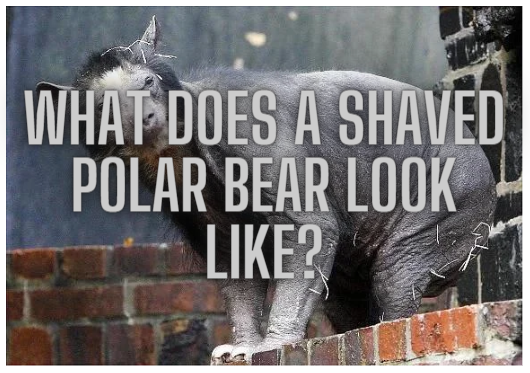The majestic polar bear (Ursus maritimus) is an iconic symbol of the Arctic, known for its thick fur that provides insulation and camouflage in its icy habitat. However, have you ever wondered what a polar bear would look like if it were shaved? In this article, we will explore the appearance of a shaved polar bear, shedding light on its hidden features and offering insights into the unique adaptations that make it perfectly suited for survival in the harsh Arctic environment.
The Fur and Skin
The most striking change when a polar bear is shaved is the exposure of its underlying skin. Without its dense fur, the bear’s skin appears black, which helps to absorb and retain heat from the sun. The dark skin provides an effective camouflage against the bright white snow and ice, allowing the bear to remain inconspicuous while hunting or evading predators.
Body Structure and Proportions
The shaved polar bear’s body structure reveals a streamlined form built for swimming and traversing long distances across the Arctic ice. The bear has a large, barrel-shaped torso supported by strong forelimbs and hindlimbs, perfect for navigating through the freezing waters and hauling itself onto the ice. The limbs appear muscular and robust, emphasizing their role in capturing prey and maintaining balance on slippery surfaces.
Facial Features
The shaved polar bear’s face exhibits distinctive characteristics. Its eyes, small and beady, are perfectly adapted for the polar environment, reducing glare and enhancing underwater vision. The bear’s ears are relatively small and rounded, minimizing heat loss in the frigid climate. The mouth reveals sharp, powerful teeth, designed for tearing through the blubber and meat of seals, the primary food source for polar bears.
Paws and Claws
The bear’s paws are broad and covered in rough pads, providing traction on the ice while walking or running. The claws, which are sharp and curved, play a crucial role in capturing prey and climbing onto the ice. The shaved paws expose the bears’ unique adaptation: small bumps known as papillae, which help to prevent slipping on the ice by increasing friction through microscopic channels that control the flow of melted ice.
Final Thoughts
While a shaved polar bear may seem unusual compared to its iconic furry appearance, it reveals a fascinating array of adaptations that enable this magnificent creature to thrive in the Arctic. The dark skin, streamlined body, specialized facial features, and powerful paws all contribute to the polar bear’s ability to navigate its icy habitat, hunt for food, and withstand the extreme conditions.
Understanding the shaved polar bear’s physical characteristics allows us to appreciate the intricate design of nature and the remarkable adaptations that have evolved over time. It also serves as a reminder of the need to protect these magnificent creatures and their fragile Arctic environment, ensuring their survival for generations to come.

